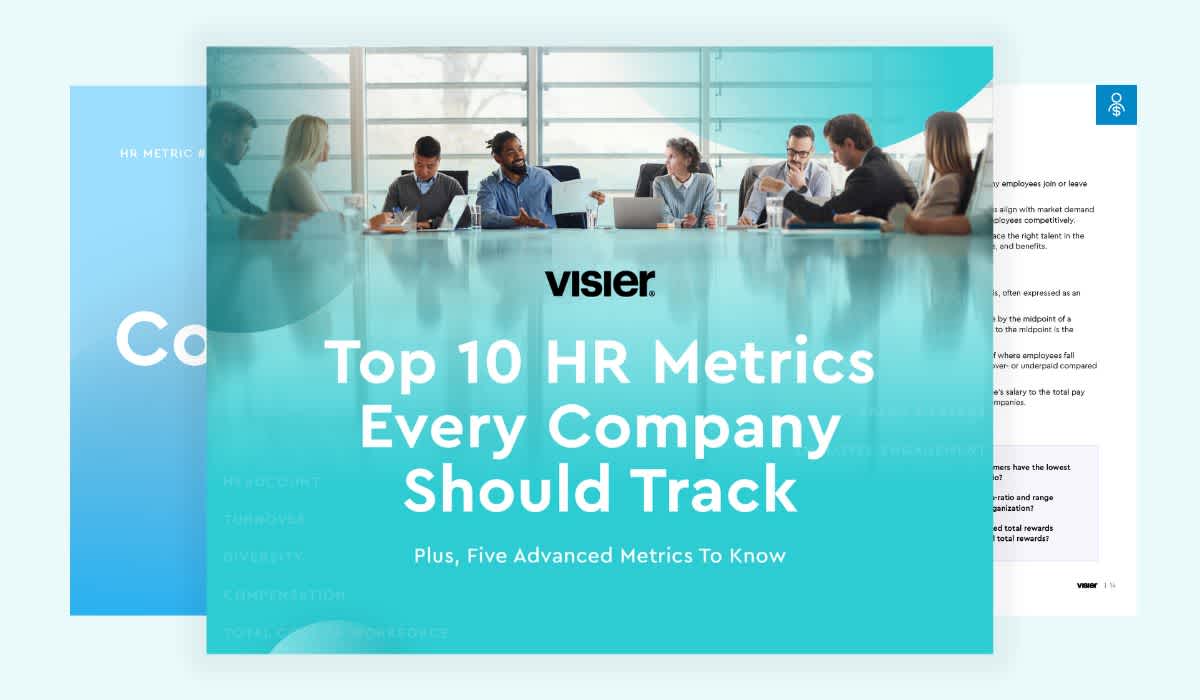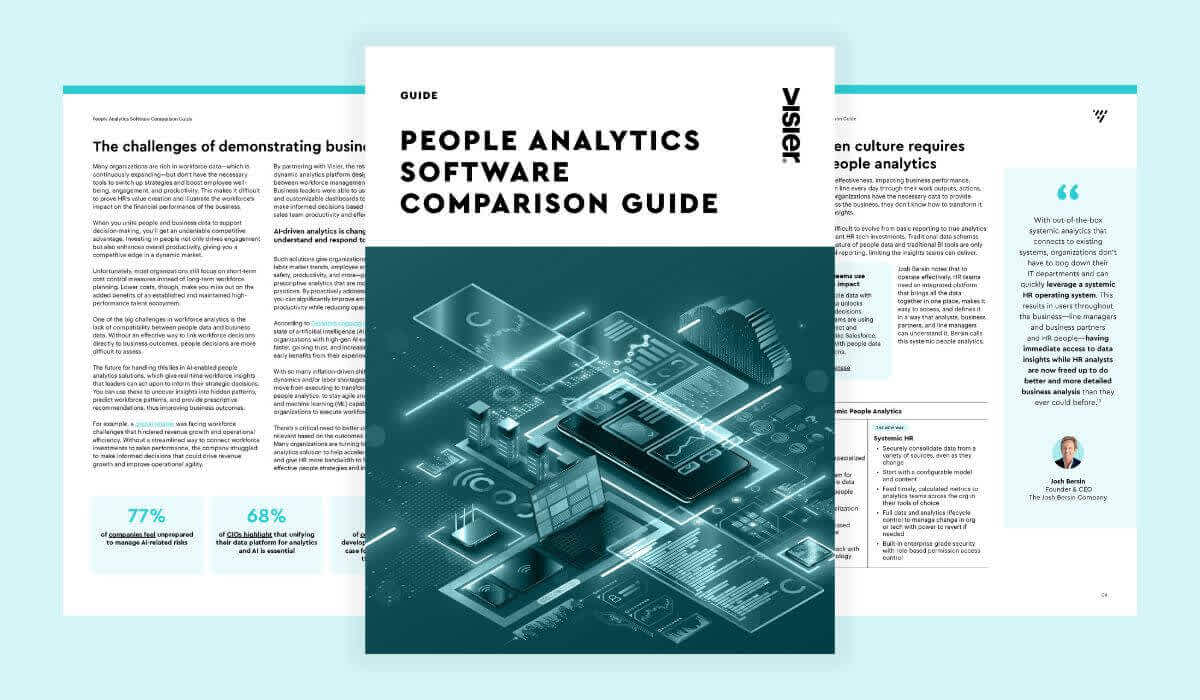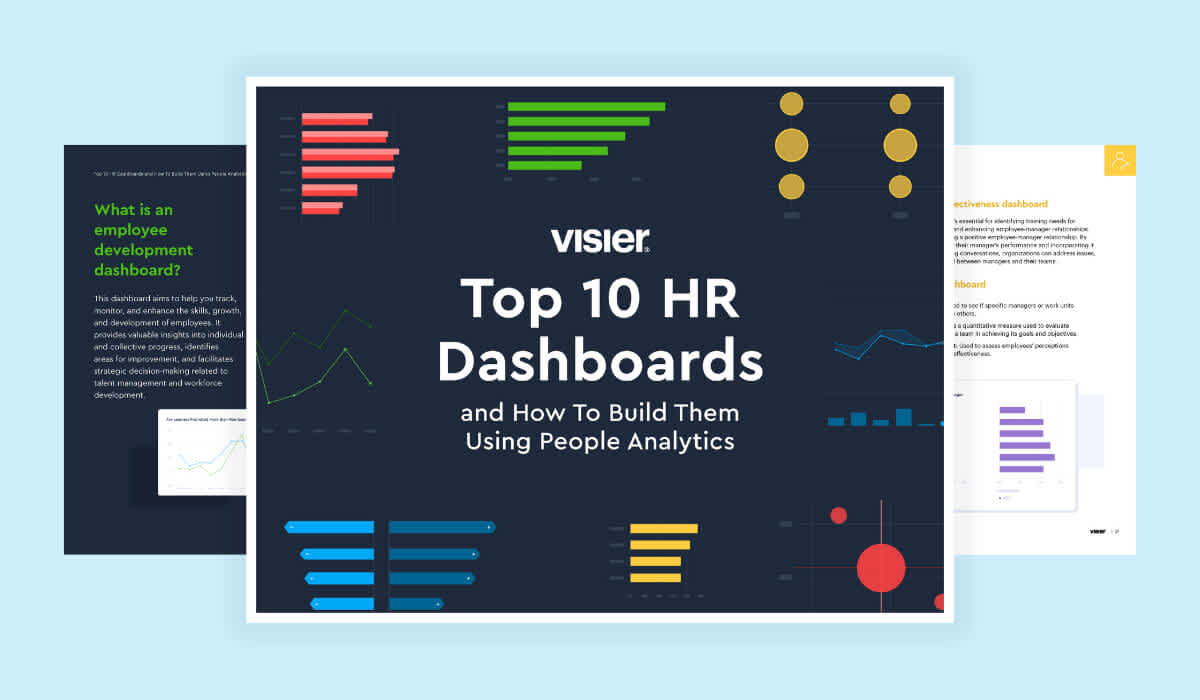The Top HR Metrics to Measure and Optimize Workforce Strategies
HR metrics help you track key workforce activities to improve employee experience and HR effectiveness. Learn the most important HR metrics to track here.

Understanding business performance requires a comprehensive approach that goes beyond financial and sales data. People data, or HR data, is crucial for gaining insights into organizational health and opportunities for growth.
That’s because it reunites various HR metrics such as employee satisfaction, retention rates, training and development, diversity and inclusion, productivity, and performance evaluations.

What are HR metrics?
Metrics are simply a way of assessing a particular area within a business. Within human resources, we measure categories of people metrics to understand how the organization’s biggest investment—its people—is faring, and how they affect the business. HR metrics help you track key workforce activities to improve employee experience, HR effectiveness, and ultimately, business performance.
There's a core set of HR metrics that every company should track to understand the impact that people have on the business, and that the business has on its people. In this post, we’ve outlined the ten most essential HR metrics to track.
Why HR metrics matter
HR metrics are data points that allow you to track key human resource and recruitment activities like employee performance, retention, compensation, engagement, cost-per-hire, time-to-hire, and more. This lets HR teams and people managers keep a close eye on how programs are functioning so that they can make adjustments if needed.
The way we work is constantly in flux. From the rapid shift to hybrid work to incorporating emerging technologies like generative AI into the workplace, HR is a forever-evolving and transforming field. HR metrics are a way of assessing a particular area within your business. They can also help you better face unforeseen events.
You need the ability to analyze workforce and people data to create an environment where people feel valued. If you don’t, you risk losing your employees’ trust and loyalty as their values shift and evolve.
Tracking essential HR metrics will help you connect people data with business outcomes to make data-informed decisions aligned with your company's goals.
Key metrics: Turnover, time to hire, cost per hire, engagement, retention
Predicting future business needs is another area where HR analytics can be helpful. How many new employees will you need? What new skills will people need and want to learn? All of this can be answered using HR metrics and can help you make better business decisions.
Turnover
If you thought replacing employees was easy, think again. The process can sometimes cost one-half to twice the employee’s annual salary. This should be a good motivation to want to reduce turnover rates.
Metrics you need to know include:
Predicted resignation: An approximate number of people who will leave the company in the near future.
Resignation trends: Are more or fewer people quitting now than in the past quarter? Can you spot any patterns?
Estimated replacement costs: How much will it cost to replace those who leave the company?
Resignation drivers: Why do people leave the organization?
The turnover rate comprises voluntary and involuntary departures. But it's the voluntary turnover metrics that should get your attention.
You can control which contracts you terminate and which people you lay off. You don’t have the same control over their resignation. Analyzing this metric will help you understand the trends and the reasons behind the employee’s decision.
Time to hire
The hiring process can become more drawn out than anyone anticipates, and not only do the delays put a damper on growth, but they also cost real money. Each day a seat remains empty, the organization suffers a loss of productivity, potential, and team momentum.
Some of the metrics that you will need to track here are:
Average time to hire: The average number of days it takes to move from a candidate applying or being sourced to the candidate accepting the offer.
Stage duration: What’s the longest part of your recruitment process?
Productivity impact: How much work are you pushing off to other workers by not filling a position?
The harmfulness of long hiring cycles is one that most businesses underestimate. They make it more likely to lose top candidates to faster-moving competitors. You'll also likely have to deal with internal squabbles over who will have to pick up the slack.
And here’s the crucial part: speed frequently translates to success. The best candidates will be off-market in only 10–14 days. If your process is 30, 45, or 60 days, you’ve already lost them.
Cost to hire
The true cost of hiring a new employee is much more than your standard HR expenses. If you’re not measuring this metric, you may be spending a lot more than you think.
From advertising and recruiter costs to interview hours, background checks, and onboarding training, things can snowball fast. The real expense of onboarding new talent is often as much, or if not more, than the cost of turnover.
That's why you should familiarize yourself with some of the following metrics:
Cost to hire: The total of direct and indirect costs to cover to fill one position.
Breakdown by role/department: Are certain roles much more expensive to recruit for?
Source efficacy: What channels are attracting the best hires at the lowest cost?
In addition to the efficiency of the hiring process, cost to hire metrics will show you how much money vs. how much time it takes to hire and maintain a great team.
And here’s the game-changer: When hiring and turnover are both high, these costs multiply. Tracking them does help you understand where you can save, optimize, and invest more wisely in the talent that powers your company’s future.
Employee engagement
Employees are a key component in any business. How well they relate to their employers, their colleagues, and the work they do are all part of the employee engagement metrics. In other words, this metric is about how connected and involved employees are in an organization.
Engaged employees are more productive. They tend to have lower rates of burnout and voluntary turnover.
Employee engagement metrics to track include:
Voluntary turnover: The proportion of employees who choose to leave employment by resignation, rather than by involuntary termination or layoff.
Absenteeism: How often employees are not at work on days they’re scheduled to be there.
Employee performance: An assessment of the success with which an employee reaches their work goals and contributes to broader organizational success.
Net promoter score (NPS) in feedback surveys: A standardized measure from employee survey responses of whether people would recommend your organization as a great place to work.
Empower people managers to see how engaged their teams are compared to the engagement trends of other organizations in the business.
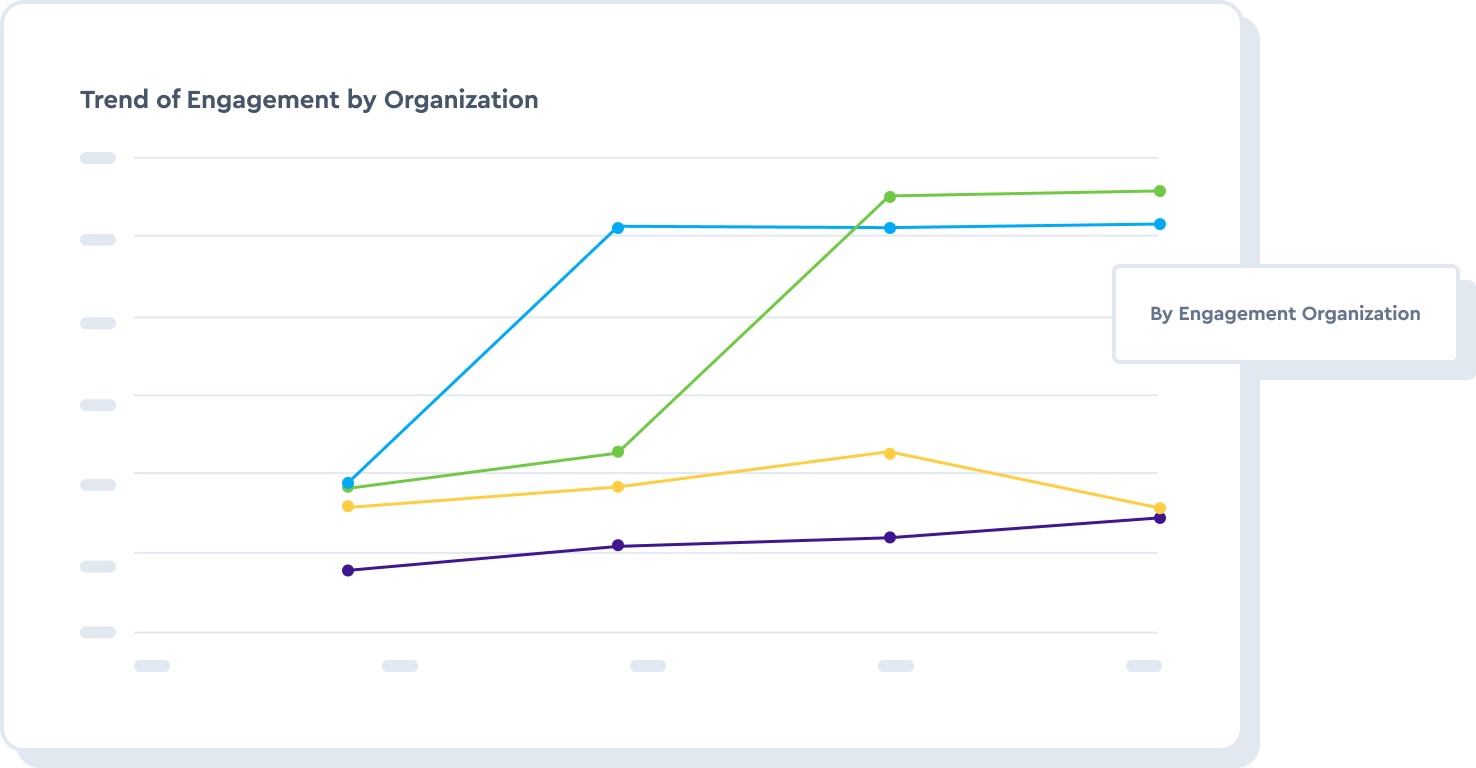
Empower people managers to see how engaged their teams are compared to the engagement trends of other organizations in the business.
Retention
Employee retention is the result of a purposeful, continuous effort, often put in place for company leaders by external advisers. Businesses that ignore retention do so at a cost, sometimes measured in expertise, productivity, or even costly hiring cycles.
High retention is when your team remains steady, engaged, and motivated. Fail to zero in on this, and hidden issues can be lurking beneath even a low turnover rate: Disengaged workers, loss of institutional knowledge, and eroding culture.
Key metrics you should take a look at are:
Retention rate: How many of your employees remain for a set period of time?
Segment retention: Is one team/department/role more likely to stay than another?
Driver analysis: What makes people stick around?
Early turnover: How many people who are hired end up leaving in their first 6–12 months?
High retention is a sign of health. It lets you focus on longer-term development and support strategic ambitions with certainty.
The secret? Proactive involvement, acknowledgment, career paths, and good supervision.
Strategic metrics: Productivity, diversity, internal mobility
Productivity
Low productivity can indicate disengaged workers, bad processes, or resource shortages. Those things all mean you lose out on competitive advantage and profits.
Here are the metrics you should be following:
Employer output per employee: Measurable outputs like the number of units per product produced, sales closed, or work tasks performed as relates to hours worked.
Quality of work: Over and above sheer quantity, this is one of the HR metrics that looks at how well jobs are performed.
Goal achievement: The degree to which employees meet or exceed individual and team performance objectives.
It’s important to track employee productivity so you can figure out what’s working, what’s not, where work is getting stuck and slowing down, and who your best employees are.
Diversity
A Harvard Business Review study showed that 76% of employees and job seekers look at diversity when considering a job offer.
What does diversity mean in a business context? It refers to the range of differences within the company, particularly related to race, gender, ethnicity, and age.
Common DEIB metrics to track include:
Ethnicity: Shows what proportion of employees belong to each ethnic group.
Gender: The count of staff by gender identity.
Location: The city or cities where workers are based.
Industry: The overall industry or segment that the organization operates in.
Examine the mean gender pay gap by organization to better understand pay equity in the business. The more diverse an organization is, the more chances it has of attracting top talent.
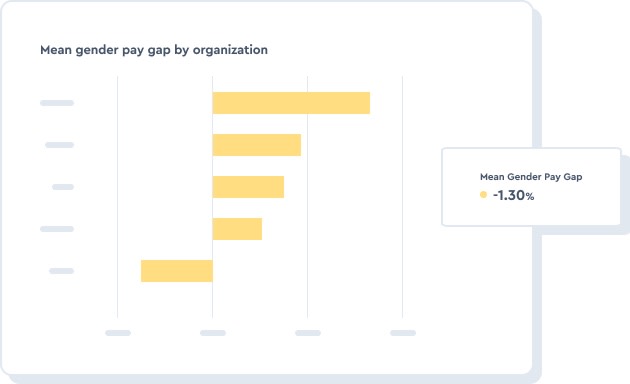
Examine the mean gender pay gap by organization to better understand pay equity in the business.
Internal mobility
Internal mobility (i.e. practice of moving employees to new positions within the organization rather than hiring from the outside) is a tool companies can use to increase engagement and retention and develop employees’ skills.
When employees have a clear direction for advancement and new challenges, they’re more likely to stay, deepen their expertise, and provide broader value to the company. Internal mobility also saves you on hiring costs and downtime because you don’t have to train someone new to your organization.
Some key metrics to be aware of are:
Internal mobility rate: The ratio of open roles that were filled by current employees, as opposed to external hires.
Rate of promotion: The frequency with which employees are promoted to a higher-level position within a specific period.
Lateral movement rate: How often employees move from one department or function to another to add breadth to their skill sets and experiential learning.
Time to fill for internal roles: A measure of how long it takes for internal candidates to be sourced, assessed, and placed into new roles.
Monitoring internal mobility provides insights into how well an organization is cultivating talent internally and enabling career progression. A focus on mobility means a more flexible, agile talent force that can meet changing business imperatives while also fostering a more motivated, engaged workforce.
Benchmarking: Industry standards and goals
Look at HR metrics devoid of external context and you'll lose out on vital insights. Benchmarking places your company’s performance alongside that of others in your industry to flag gaps, best practices, and strategic targets for improvement.
HR teams can use this data-driven goal setting to monitor benchmarks and identify areas where they may need to improve, like talent management, retention, and productivity.
Studies show that companies that use people analytics are experiencing a 25% increase in business productivity.
The standard HR-to-employee ratio these days is about 1:50 or 2%, which would suggest two HR persons for every 100 employees.
The average cost per hire will vary, but once you take into consideration recruitment, training, and internal costs, it can amount to thousands of dollars per new employee.
How to use these benchmarks
Industry standards act as the core benchmark by which you can judge your own company’s performance.
To ensure you don’t stagnate, it’s important to understand where your organization stands so you can fill in the gaps in your defenses more effectively. Benchmarks also provide best practices and thought starters for what success looks like in similar organizations.
Real data-driven benchmarking is far better than goal setting. Clear goals create team alignment and support accountability. With this approach, HR metrics step up from isolated numbers to true, actionable drivers of strategy as well as ongoing improvement.
Reporting tools: Dashboards and analytics platforms
Your HR function depends on analytics platforms and intuitive dashboards to sort through and interpret many types of complex workforce data. They help you pull in, analyze, and visualize metrics on everything from turnover and productivity to diversity and internal flow.
Top functions of HR analytics software:
Data centralization and visualization: Dashboards pull all your data from HRIS, ATS, payroll, performance, and engagement tools to give you a cohesive perspective on workforce metrics and insights.
Real-time data intelligence: Platforms such as Visier serve up real-time intelligence on critically important topics like attrition risk, employee sentiment, DEI goals, flight risk, and others.
Predictive and prescriptive analytics: Next-generation platforms rely on AI and machine learning to predict future trends, like turnover, dips in productivity, or increases in absenteeism, plus offer prescriptive recommendations based on that data.
Scenario planning: Plan your workforce by modeling scenarios, simulating outcomes, and being more proactive with talent needs as business changes.
Custom reporting: Create personalized reports for executives or specific groups of managers so you can drill down into data before making a decision.
A closer look at Visier's approach to HR metrics
The platform is designed to help you tell a story rather than simply display data with pre-built visualizations on subjects such as attrition, internal mobility, as well as DEI.
Easy to connect with all major HR and payroll systems, Visier automates data integration, reducing massive amounts of manual work and ensuring accurate information for:
A deeper dive into attrition so you can better identify trends
Tracking how diversity is broken down by department and one level at a time
Seeing how internal mobility looks like within your organization and what opportunities you might have missed
Getting predictive insights and recommendations with Workforce AI Edge so your organization will be 3x more likely to surpass financial targets
Acting on metrics: From insight to action
Gathering and reporting on HR metrics is only worth it when you can make these insights reveal the true risks and opportunities behind employee performance and behavior. Decisions need to be data-driven, strategies should be based on insights, and interventions need to occur on time if you want to create a better employee experience and achieve your overarching business goals.
The best companies will strive to create a culture in which all business leaders have access to timely HR metrics. This way, data-driven insights become part of the daily conversation and decision-making about employee performance. These companies should also operate as a transparent organization, keeping teams engaged and feeling like they're collectively owning the successes and challenges.
To make data actionable, companies need to connect the dots between metrics and clear objectives, resource strategically, and focus on specific initiatives. From turnover triggers to speeding up internal mobility or trying to improve productivity, making data-driven decisions mitigates guessing and maximizes impact.

FAQs
What are the most critical HR metrics?
Critical HR metrics that are important to measure are turnover rate, time to hire, cost to hire, retention, productivity, and engagement. These qualities are key to understanding workforce stability, efficiency, and the employee experience as a whole.
How do HR metrics support business strategy?
HR metrics allow you to connect the dots between talent management and business targets by clearly highlighting talent gaps, honing the hiring process, evaluating employee performance, and optimizing retention programs. They transform workforce data into meaningful and easy-to-understand insights, enabling decision-making based on hard evidence.
What metrics predict workforce trends?
Predictive measures, such as intentions to leave, absence, engagement levels, and movement within the firm, will assist in forecasting change and volatility in the workforce. These warnings are useful in forecasting talent requirements and avoiding risks.
How should HR metrics be reported?
HR metrics should be visualized using intuitive, interactive dashboards and custom reports that focus on important trends and findings. The reports must display time on time, be relevant to an audience, and be tied to strategic objectives to incite action.
